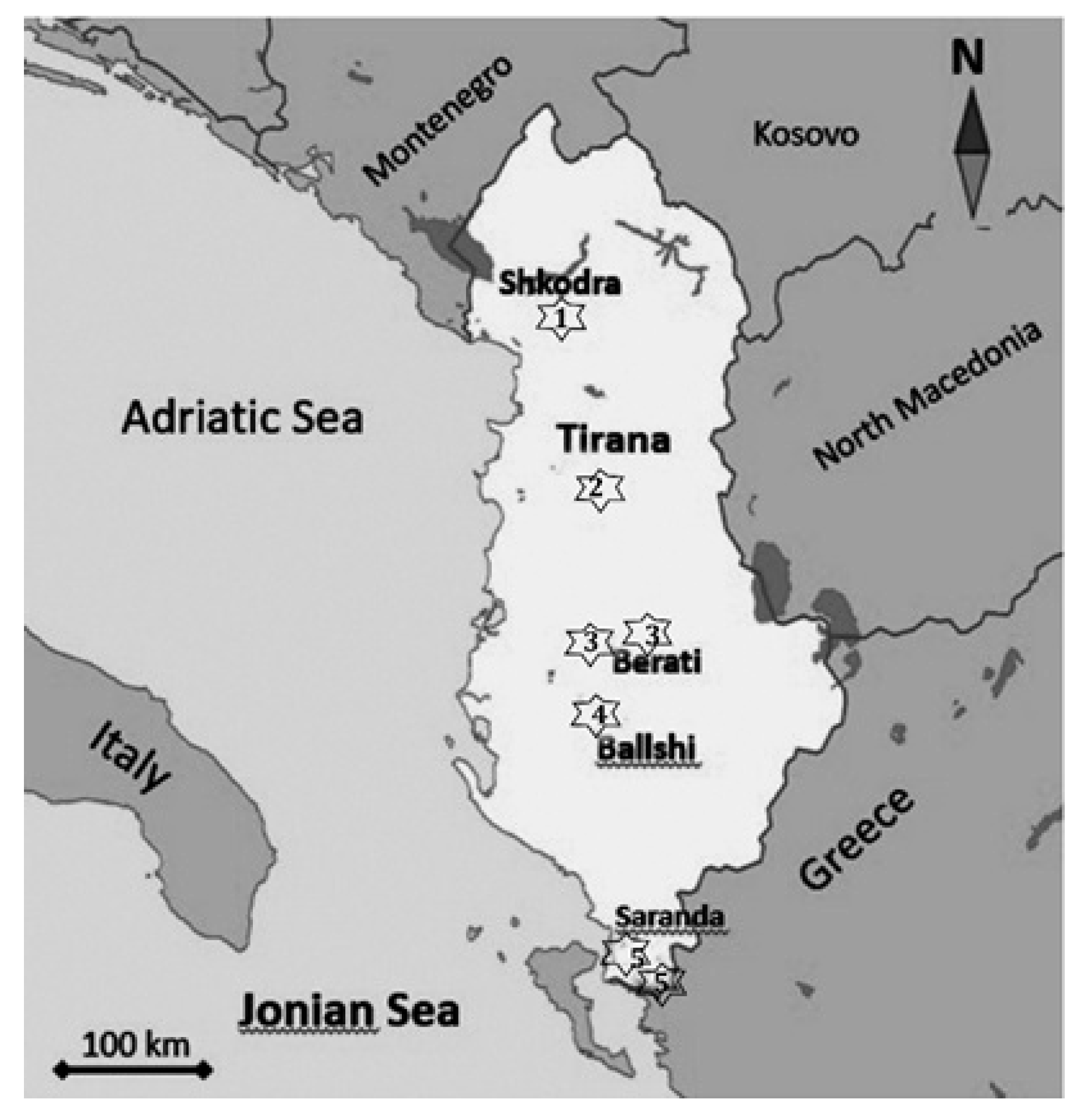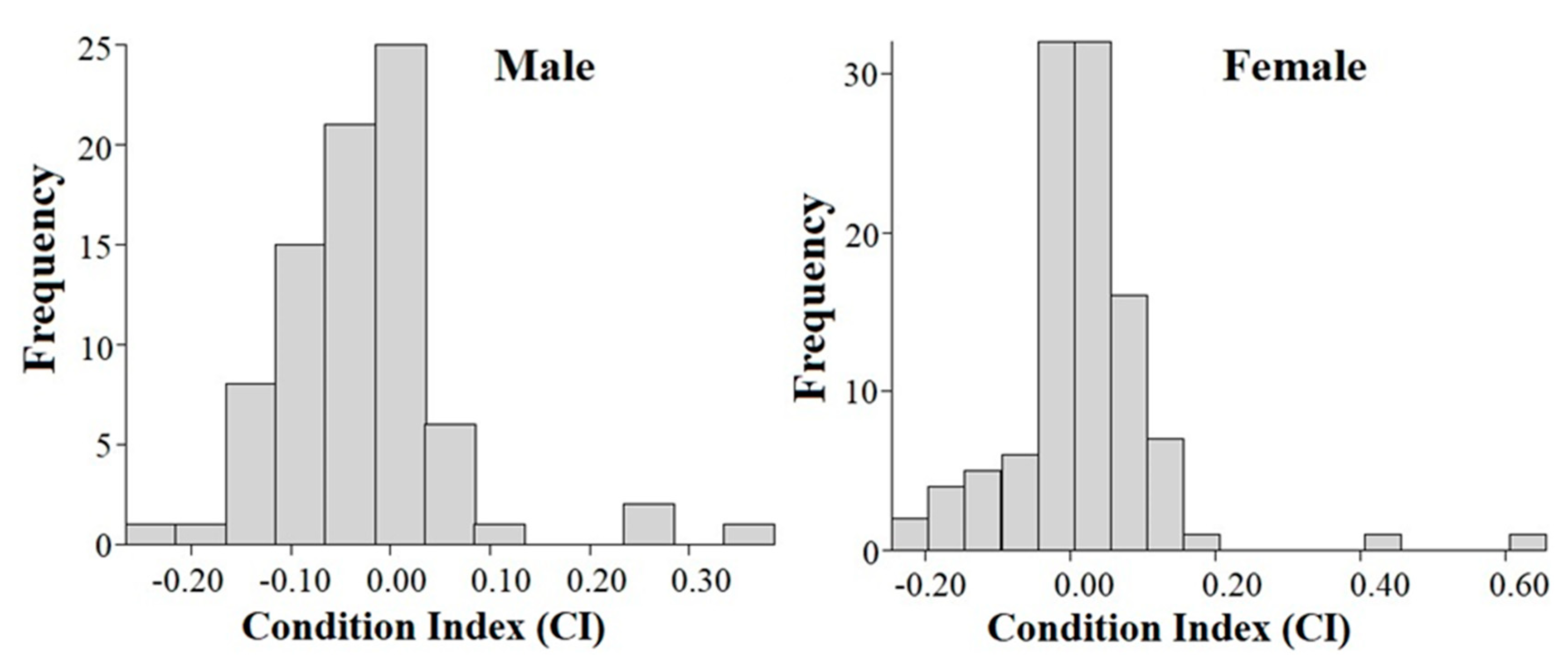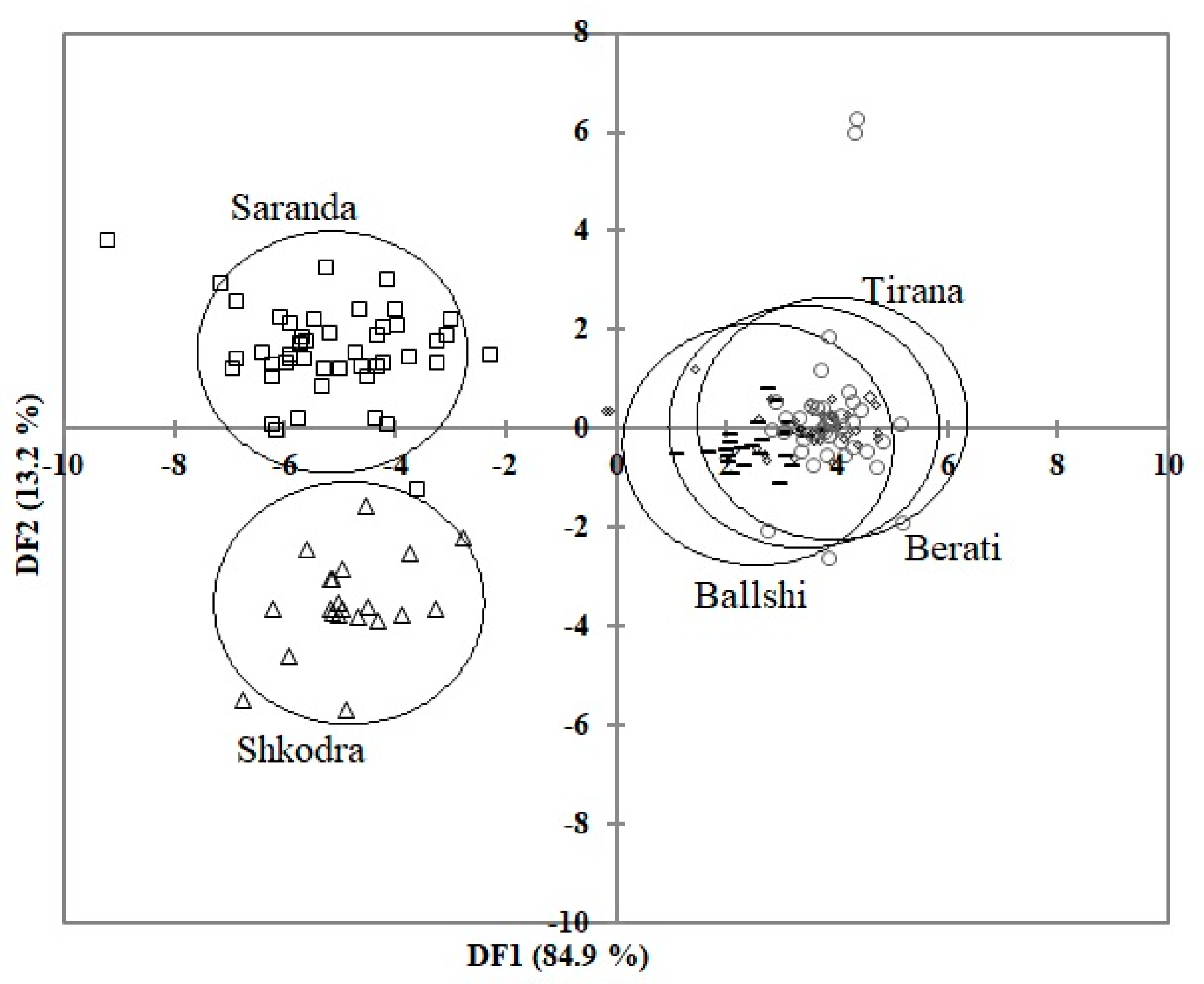Morphological Divergence of Hermann’s Tortoise (Testudo hermanni boettgeri Mojsisovits, 1889) in Albania
Abstract
Simple Summary
Abstract
1. Introduction
2. Materials and Methods
2.1. Study Area
2.2. Data Collection and Measurements
2.3. Statistical Analysis
3. Results
4. Discussion
5. Conclusions
Supplementary Materials
Author Contributions
Funding
Institutional Review Board Statement
Informed Consent Statement
Data Availability Statement
Acknowledgments
Conflicts of Interest
References
- Cheylan, M. Testudo hermanni Gmelin, 1798–Griechische Landschildkröten. In Handbuch der Reptilien und Amphibien Europas. Band 3/IIIA: Schildkröten (Testudines). I. (Bataguridae, Testudinidae, Emydidae); Fritz, U., Ed.; Aula-Verlag: Wiebelsheim, Germany, 2001; pp. 179–289. [Google Scholar]
- Mazzotti, S. Testuggine di Hermann. In Atlante Degli Anfibi e dei Rettili d’Italia; Sindaco, R., Doria, G., Razzetti, E., Bernini, F., Eds.; Edizioni Polistampa: Firenze, Italy, 2006; pp. 390–395. [Google Scholar]
- Vetter, H. La Tortuga Mediterránea Testudo hermanni; Edition Chimairia: Frankfurt, Germany; Reptilia Ediciones: Castelldefels, Spain, 2006; p. 325. [Google Scholar]
- IUCN. The IUCN Red List of Threatened Species. 2020. Available online: http://www.iucnredlist.org/ (accessed on 15 September 2008).
- Auliya, M.; Altherr, S.; Ariano-Sanchez, D.; Baard, E.H.; Brown, C.; Brown, R.M.; Cantu, J.-C.; Gentile, G.; Gildenhuys, P.; Henningheim, E.; et al. Trade in live reptiles, its impact on wild populations, and the role of the European market. Biol. Conserv. 2016, 204, 103–119. [Google Scholar] [CrossRef]
- Türkozan, O.; Kiremit, F.; Brian, R.L.; Bardakçı, F.; Parham, J.F. Morphological and mitochondrial variation of spur-thighed tortoises, Testudo graeca, in Turkey. Herpetol. J. 2018, 28, 1–9. [Google Scholar]
- Turkozan, O.; Yilmaz, C.; Karakaya, Ş.; Karaman, S.; Ülger, C. Distribution, Size, and Demographics of Eastern Hermann’s Tortoise, Testudo hermanni boettgeri, in Turkey. Chelonian Conserv. Biol. 2019, 18, 210. [Google Scholar] [CrossRef]
- Kicaj, H.; Saçdanaku, E.; Shkurtaj, B. Morphometric Data of Testudo Hermanni in the Vlora Area. J. Life Sci. 2016, 10, 307–311. [Google Scholar] [CrossRef][Green Version]
- Fritz, U.; Auer, M.; Bertolero, A.; Cheylan, M.; Fattizzo, T.; Hundsdörfer, A.K.; Sampayo, M.M.; Pretus, J.L.; Široký, P.; Wink, M. A rangewide phylogeography of Hermann’s tortoise, Testudo hermanni (Reptilia: Testudines: Testudinidae): Implications for taxonomy. Zool. Scr. 2006, 35, 531–543. [Google Scholar] [CrossRef]
- Bertolero, A.; Cheylan, M.; Hailey, A.; Livoreil, B.; Willemsen, R.E. Testudo hermanni (Gmelin 1789)—Hermann’s Tortoise. In Conservation Biology of Freshwater Turtles and Tortoises: A Compilation Project of the IUCN/SSC Tortoise and Freshwater Turtle Specialist Group; Rhodin, A.G.J., Pritchard, P.C.H., van Dijk, P.P., Saumure, R.A., Buhlmann, K.A., Iverson, J.B., Mittermeier, R.A., Eds.; Chelonian Research Monographs: Lunenburg, MA, USA, 2011; pp. 059.1–059.20. [Google Scholar] [CrossRef]
- Soler, J.; Pfau, B.; Martínez-Silvestre, A. Detecting intraspecific hybrids in Testudo hermanni (Gmelin 1789). Radiata 2012, 21, 4–29. [Google Scholar]
- Evans, H.E. Reptiles—Introduction and anatomy. In Zoo and Wild Animal Medicine, 2nd ed.; Fowler, M.E., Ed.; WB Saunders: Philadelphia, PA, USA, 1986; pp. 108–132. [Google Scholar]
- Girling, S.J. Veterinary Nursing of Exotic Pets, 2nd ed.; Wiley-Blackwell: New York, NY, USA, 2013. [Google Scholar]
- O’Malley, B. Clinical Anatomy and Physiology of Exotic Species. Structure and Function of Mammals, Birds, Reptiles and Amphibians; Elsevier Limited Saunders: Philadelphia, PA, USA, 2005; ISBN 978-0702027826. [Google Scholar]
- Djordjević, S.; Tomović, L.; Golubović, A.; Simović, A.; Sterijovski, B.; Djurakić, M.; Bonnet, X. Geographic (in) variability of ender-specific traits in Hermann’s tortoise. Herpetol. J. 2013, 23, 67–74. [Google Scholar]
- Ben Kaddour, K.; El Mouden, E.H.; Slimani, T.; Bonnet, X.; Lagarde, F. Sexual Dimorphism in the Greek Tortoise: A Test of the Body Shape Hypothesis. Chelonian Conserv. Biol. 2008, 7, 21–27. [Google Scholar] [CrossRef]
- Djordjević, S.; Djurakić, M.; Golubović, A.; Ajtić, R.; Tomović, L.; Bonnet, X. Sexual body size and body shape dimorphism of Testudo hermanni in central and eastern Serbia. Amphibia-Reptilia 2011, 32, 445–458. [Google Scholar]
- Chiari, Y.; Claude, J. Study of the carapace shape and growth in two Galápagos tortoise lineages. J. Morphol. 2011, 272, 379–386. [Google Scholar] [CrossRef]
- Berry, J.F.; Shine, R. Sexual size dimorphism and sexual selection in turtles (order testudines). Oecologia 1980, 44, 185–191. [Google Scholar] [CrossRef] [PubMed]
- Stubbs, D.; Hailey, A.; Pulford, E.; Tyler, W. Population Ecology of European Tortoises: Review of Field Techniques. Amphibia-Reptilia 1984, 5, 57–68. [Google Scholar] [CrossRef]
- Willemsen, R.E.; Hailey, A. Sexual dimorphism of body size and shell shape in European tortoises. J. Zool. 2003, 260, 353–365. [Google Scholar] [CrossRef]
- Sacchi, R.; Rosa, D.P.; Pupin, F.; Fasola, M. Bergmann’s rule and the Italian Hermann’s tortoises (Testudo hermanni): Latitudinal variations of size and shape. Amphibia-Reptilia 2007, 28, 43–50. [Google Scholar] [CrossRef]
- Široký, P.; Fritz, U. Is Testudo werneri a distinct species? Biologia 2007, 62, 228–231. [Google Scholar] [CrossRef]
- Casalduero, A.G.; Rouag, R.; Jdeidi, T.; Fahd, S.; Hundsdörfer, A.; Harris, D.J.; Fritz, U.; Kalboussi, M.; Široký, P.; Martínez, E.G. Mitochondrial phylogeography of Testudo graeca in the Western Mediterranean: Old complex divergence in North Africa and recent arrival in Europe. Amphibia-Reptilia 2009, 30, 63–80. [Google Scholar] [CrossRef]
- Ljubisavljević, K.; Džukić, G.; Vukov, T.; Kalezić, M. Morphological variability of the Hermann’s tortoise (Testudo hermanni) in the Central Balkans. Acta Herpetol. 2012, 7, 253–262. [Google Scholar]
- Đurakić, M.R.; Milankov, V.R. Carapace shape variation of genetically divergent populations of Testudo hermanni boettgeri (Reptilia: Testudines). Arch. Biol. Sci. 2019, 71, 609–619. [Google Scholar] [CrossRef]
- Werner, Y.L.; Korolker, N.; Sion, G.; Göçmen, B. Bergmann’s and Rensch’s rules and the spur-thighed tortoise (Testudo graeca). Biol. J. Linn. Soc. 2015, 117, 796–811. [Google Scholar] [CrossRef]
- Carretero, M.A.; Znari, M.; Macé, J.; Harris, D.J. Morphological divergence among populations of Testudo graeca from west-central Morocco. Anim. Biol. 2005, 55, 259–279. [Google Scholar] [CrossRef]
- Kiremit, F.; Taşkavak, E.; Parham, J.; Türkozan, O.; Olgun, K. A quantitative reassessment of morphology-based taxonomic schemes for Turkish tortoises (Testudo graeca). Amphibia-Reptilia 2010, 31, 69–83. [Google Scholar] [CrossRef]
- Beshkov, V.A. Record–sized tortoises Testudo graeca ibera and Testudo hermanni boettgeri from Bulgaria. Chelonian Conserv. Biol. 1997, 2, 593–596. [Google Scholar]
- Willemsen, R.E.; Hailey, A. A latitudinal cline of dark plastral pigmentation in the tortoise Testudo hermanni in Greece. Herpetol. J. 1999, 9, 125–132. [Google Scholar]
- The Monthly Climatic Bulletin; Institute of Geosciences, Energy, Water and Environment, Polytechnic University of Tirana: Tirana, Albania, 2019.
- Sherifaj, M. Mallakastra—Studim Gjeografik. Ph.D. Thesis, University of Tirana, Tirana, Albania, 2015. [Google Scholar]
- Hailey, A. Assessing body mass condition in the tortoise Testudo hermanni. Herpetol. J. 2000, 10, 57–61. [Google Scholar]
- Willemsen, R.E.; Hailey, A. Body mass condition in Greek tortoises: Regional and interspecific variation. Herpetol. J. 2002, 12, 105–114. [Google Scholar]
- Olson, C.L. Comparative robustness of six tests in multivariate analysis of variance. J. Am. Stat. Assoc. 1974, 69, 894–908. [Google Scholar] [CrossRef]
- Dasgupta, S. Pillai’s Trace Test. In Encyclopedia of Biostatistics; Wiley: New York, NY, USA, 2005. [Google Scholar]
- Hailey, A.; Wright, J.; Steer, E. Population ecology and conservation of tortoises: The effects of disturbance. Herpetol. J. 1988, 1, 294–301. [Google Scholar]
- Meek, R. Aspects of the ecology of Testudo hermanni in southern Yugoslavia. Br. J. Herpetol. 1985, 6, 437–445. [Google Scholar]
- Lovich, J.E.; Gibbons, J.W. Age at Maturity Influences Adult Sex Ratio in the Turtle Malaclemys terrapin. Oikos 1990, 59, 126. [Google Scholar] [CrossRef]
- Hailey, A.; Willemsen, R.E. Population density and adult sex ratio of the tortoise Testudo hermanni in Greece: Evidence for intrinsic population regulation. J. Zool. 2000, 251, 325–338. [Google Scholar] [CrossRef]
- Willemsen, R.E.; Hailey, A. Variation of adult body size of the tortoise Testudo hermanni in Greece: Proximate and ultimate causes. J. Zool. 1999, 248, 379–396. [Google Scholar] [CrossRef]
- Ashton, K.G.; Feldman, C.R. Bergmann’s rule in nonavian reptiles: Turtles follow it, lizards and snakes reverse it. Evolution 2003, 57, 1151–1163. [Google Scholar] [CrossRef] [PubMed]
- Iverson, J.B. Correlates of Reproductive Output in Turtles (Order Testudines). Herpetol. Monogr. 1992, 6, 25. [Google Scholar] [CrossRef]
- Fitch, H.S. Variation in Clutch and Litter Size in New World Reptiles; Fitch, H.S., Ed.; Smithsonian Institution: Washington, DC, USA, 1985; Volume 76, pp. 1–76. [Google Scholar]
- Hailey, A.; Loumbourdis, N.S. Egg size and shape, clutch dynamics, and reproductive effort in European tortoises. Can. J. Zool. 1988, 66, 1527–1536. [Google Scholar] [CrossRef]
- Iverson, J.B.; Balgooyen, C.P.; Byrd, K.K.; Lyddan, K.K. Latitudinal variation in egg and clutch size in turtles. Can. J. Zool. 1993, 71, 2448–2461. [Google Scholar] [CrossRef]
- Pincheira-Donoso, D.; Hodgson, D.; Tregenza, T. The evolution of body size under environmental gradients in ectotherms: Why should Bergmann’s rule apply to lizards? BMC Evol. Biol. 2008, 8, 68. [Google Scholar] [CrossRef]
- Sibeaux, A.; Michael, C.H.; Bonnet, X.; Caron, S.; Fournie’re, K.; Gagno, S.; Ballouard, J.M. Sex specific ecophysiological responses to environmental fluctuations of free-ranging Harmann’s tortoises: Implication for conservation. Conserv. Physiol. 2016, 4, cow054. [Google Scholar] [CrossRef]
- Willemsen, R.E.; Hailey, A. Variation in adult survival rate of the tortoise Testudo hermanni in Greece: Implications for evolution of body size. J. Zool. 2001, 255, 43–53. [Google Scholar] [CrossRef]
- Krofel, M. Predation and partial consumption of an adult Hermann’s tortoise (Testudo hermanni Gmelin, 1789) by a brown bear (Ursus arctos Linnaeus, 1758). Herpetol. Notes 2012, 5, 499–501. [Google Scholar]
- Sönmez, B. Morphological Variations in the Green Turtle (Chelonia mydas): A Field Study on an Eastern Mediterranean Nesting Population. Zool Stud. 2019, 58, e16. [Google Scholar]
- Djurakić, M.; Milankov, V. The utility of plastron shape for uncovering cryptic diversity in Hermann’s tortoise. J. Zool. 2019, 310, 145–157. [Google Scholar] [CrossRef]





| Regions | n | Mean ± Std Dev | Min–Max |
|---|---|---|---|
| Shkodra | 21 | −0.01 ± 0.13 | −0.19–0.43 |
| Tirana | 40 | 0.03 ± 0.06 | −0.06–0.36 |
| Berati | 53 | 0.00 ± 0.08 | −0.23–0.19 |
| Ballshi | 25 | −0.02 ± 0.04 | −0.10–0.08 |
| Saranda | 49 | −0.02 ± 0.12 | −0.22–0.61 |
| Total | 188 | 0.00 ± 0.09 | −0.23–0.61 |
| Regions | Berati | Shkodra | Saranda | Ballshi | Tirana | Total |
|---|---|---|---|---|---|---|
| Berati | 69.8 | 0.0 | 0.0 | 5.7 | 24.5 | 100.0 |
| Shkodra | 0.0 | 100.0 | 0.0 | 0.0 | 0.0 | 100.0 |
| Saranda | 0.0 | 0.0 | 100.0 | 0.0 | 0.0 | 100.0 |
| Ballshi | 4.0 | 0.0 | 0.0 | 68.0 | 28.0 | 100.0 |
| Tirana | 7.5 | 0.0 | 0.0 | 10.0 | 82.5 | 100.0 |
Publisher’s Note: MDPI stays neutral with regard to jurisdictional claims in published maps and institutional affiliations. |
© 2021 by the authors. Licensee MDPI, Basel, Switzerland. This article is an open access article distributed under the terms and conditions of the Creative Commons Attribution (CC BY) license (http://creativecommons.org/licenses/by/4.0/).
Share and Cite
Duro, S.; Sönmez, B.; Gündemir, O.; Jashari, T.; Szara, T. Morphological Divergence of Hermann’s Tortoise (Testudo hermanni boettgeri Mojsisovits, 1889) in Albania. Animals 2021, 11, 134. https://doi.org/10.3390/ani11010134
Duro S, Sönmez B, Gündemir O, Jashari T, Szara T. Morphological Divergence of Hermann’s Tortoise (Testudo hermanni boettgeri Mojsisovits, 1889) in Albania. Animals. 2021; 11(1):134. https://doi.org/10.3390/ani11010134
Chicago/Turabian StyleDuro, Sokol, Bektaş Sönmez, Ozan Gündemir, Tefik Jashari, and Tomasz Szara. 2021. "Morphological Divergence of Hermann’s Tortoise (Testudo hermanni boettgeri Mojsisovits, 1889) in Albania" Animals 11, no. 1: 134. https://doi.org/10.3390/ani11010134
APA StyleDuro, S., Sönmez, B., Gündemir, O., Jashari, T., & Szara, T. (2021). Morphological Divergence of Hermann’s Tortoise (Testudo hermanni boettgeri Mojsisovits, 1889) in Albania. Animals, 11(1), 134. https://doi.org/10.3390/ani11010134







